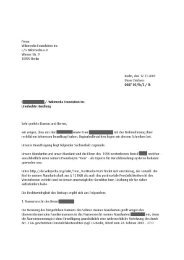Proceedings
Proceedings
Proceedings
Create successful ePaper yourself
Turn your PDF publications into a flip-book with our unique Google optimized e-Paper software.
| 96<br />
# echo “/dev/ad0.elia / ufs rw 1 1” >> /removable/etc/fstab<br />
It is important to note that this file must be stored on the removable medium and<br />
serves only the purpose of specifying the device for the root filesystem. As soon as the<br />
kernel has read out the contents of the file, it will mount the specified device as the root<br />
filesystem and the files on the removable medium (including fstab) will be outside of the<br />
filesystem name space. This means that the removable medium must first be mounted<br />
before the files on it can be accessed through the filesystem name space. It also means,<br />
however, that the removable medium can actually be removed after the root filesystem<br />
has been mounted from the encrypted hard disk – thus reducing unnecessary exposure.<br />
It is crucial that the removable medium be always in the possession of the user, because<br />
the whole concept of complete hard disk encryption relies on the assumption that the<br />
boot medium – therefore the removable medium, not the hard disk – is uncompromised<br />
and its contents are trusted.<br />
If any other partitions need to be mounted in order to boot up the system – for<br />
example /dev/ad0.elid for /usr – they must be specified in /etc/fstab as well. Since most<br />
installations use at least one swap partition, the command for adding the appropriate<br />
entry to /etc/fstab is given below.<br />
# echo “/dev/ad0.elib none swap sw 0 0“ > /fixed/etc/fstab<br />
The system is now ready for use and can be booted from the removable medium. As<br />
the different storage devices in the system are found, GELI searches them for any<br />
partitions that were initialized with the geli init -b parameter and asks for the<br />
passphrase. If the correct one has been provided, GELI will create new device nodes for<br />
plain text access to the hard disk and the partitions on it (e.g. /dev/ad0.elia), which then<br />
can then be mounted as specified in /etc/fstab.<br />
After that, the rest of the system is loaded. sysinstall can then be used in order to<br />
adjust the various settings that could not be set during the installation procedure – such<br />
as timezone, keyboard map and especially the root password!<br />
������������������������������������������<br />
���������������������������������������������<br />
Any user seriously thinking about using complete hard disk encryption should be aware<br />
of what it actually protects and what it does not.<br />
Since encryption requires a lot of processing power and can therefore have a<br />
noticeable impact on performance, it is usually not enabled by default. FreeBSD marks<br />
no exception here. Although it provides strong encryption algorithms and two powerful<br />
tools for encrypting storage media, it is up to the user to discover and apply this<br />
functionality.<br />
This paper gave instructions on how to encrypt an entire hard disk while most of the<br />
operating system is still stored and loaded from it. It is important to remember, however,<br />
that FreeBSD – or any other software component for that matter – will not warn the user<br />
if the encrypted data on the hard disk is leaked (see chapter 2.3) or intentionally copied<br />
to another, unencrypted medium, such as an external drive or a smart media card. It is<br />
the responsibility of the user to encrypt these media as well.<br />
This responsibility applies equally well to data in transit. Network transmissions are<br />
-20-






